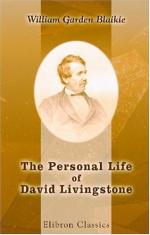“27_th_.—Went
through the whole house with our kind hosts,
and saw all the wonders,
which would require many days
properly to examine....
“2_d October_.—Took
Communion in the chapel of the Abbey.
God grant me to be and
always to act as a true Christian.
“3_d._—Mr.
and Mrs. Webb kindness itself personified. A
blessing be on them
and their children from the Almighty!”
When first invited to reside at Newstead Abbey, Dr. Livingstone declined, on the ground that he was to be busy writing a book, and that he wished to have some of his children with him, and in the case of Agnes, to let her have music lessons. His kind friends, however, were resolved that these reasons should not stand in the way, and arrangements were made by them accordingly. Dr. Livingstone continued to be their guest for eight months, and received from them all manner of assistance. Sometimes Mr. and Mrs. Webb, Mrs. Goodlake (Mrs. Webb’s mother), and his daughter Agnes would all be busy copying his journals. The “Livingstone room,” as it is called, in the Sussex tower, is likely to be associated with his name while the building lasts. It was his habit to rise early and work at his book, to return to his task after breakfast and continue till luncheon and in the afternoon have a long walk with Mr. Webb. It is only when the book is approaching its close that we find him working “till two in the morning.” One of his chief recreations was in the field of natural history, watching experiments with the spawning of trout. He endeared himself to all, high and low; was a special favorite with the children, and did not lose opportunities to commend, in the way he thought best, those high views of life and duty which had been so signally exemplified in his own career. The playfulness of his nature found full and constant scope at Newstead; he regained an almost boyish flow of animal spirits, reveled in fun and frolic in his short notes to friends like Mr. Young, or Mr. Webb when he happened to be absent; wrote in the style of Mr. Punch, and called his opponents by ludicrous names; yet never forgot the stern duty that loomed before him, or allowed the enjoyment and abandon of the moment to divert him from the death-struggle on behalf of Africa in which he had yet to engage.
The book was at first to be a little one,—a blast of the trumpet against the monstrous slave-trade of the Portuguese; but it swelled to a goodly octavo, and embraced the history of the Zambesi Expedition. Charles Livingstone had written a full diary, and in order that his name might be on the title-page, and he might have the profits of the American edition, his journal was made use of in the writing of the book; but the arrangement was awkward; sometimes Livingstone forgot the understanding of joint-authorship, and he found that he could more easily have written the whole from the foundation, At first it was designed that the book should appear early in the summer of 1865, but when the printing was finished the map was not ready; and the publication had to be delayed till the usual season in autumn.




